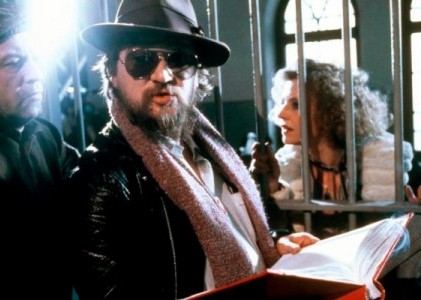The Single Antidote to Thoughts of Suicide
The following talk was given on June 10, 2012, in Berlin as part of "Hands on Fassbinder," a series of lectures and screenings organized by the editors of Revolver. It was preceded by Thomas Elsaesser’s paper "Time Warps and Time Exposures: 1979, Fassbinder and The Third Generation" and followed by Manfred Hermes’s "Gravity Beyond Its Cinematographic Mass," a paper on Berlin Alexanderplatz, as well as a discussion moderated by David Hudson.
I’m going to give a brief history of Rainer Werner Fassbinder’s American reception and then speak a bit about how that reception, at least in New York, was initially determined by three local institutions, the New York Film Festival (which then as now served as a point of entry for foreign-language filmmakers), the New York Times (which then as now was the city’s most important cultural arbiter), and the distribution company New Yorker Films: these were Fassbinder’s American friends.1
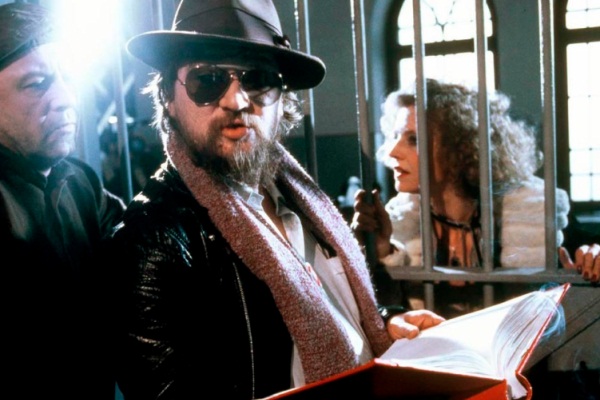
Rainer Werner Fassbinder on the set of Berlin Alexanderplatz
My thanks for inviting me to participate in this event as well as facilitating that participation by having this part of the program in a foreign language, English. I hope I won’t offend you if I begin by observing that for an American of my generation, born shortly after World War II, the sound of conversational German emanating from the screen was uncanny and even menacing, a vehicle for barked Gestapo torturers or sneering East German spies. As late as 1976, Village Voice critic Andrew Sarris would cite "a commercial jinx against German-language films in the New York area, at least partly for reasons that are too painfully obvious to mention."
"Jinx," which connotes "bad luck," is too coy a word to account for this provincialism, as is the reference to the New York area. The German language was stigmatized by powerful negative associations particularly but not exclusively among Jews and political leftists. German silent cinema was enshrined but the entirety of German talkies was reduced to a single letter M, which also happened to be a movie about the worst sort of human monster, a serial child killer. M opened up on the void and there was nothing like it…until Fassbinder. He dispelled the jinx.
I’m talking from the perspective of a civilian filmgoer rather than a professional movie critic. I did not review any of the movies I’ll be citing. In fact, the first thing I ever wrote about Fassbinder was an obituary for a no-longer extant journal, American Film. But I did follow Fassbinder’s American career from the cheap seats. I saw The Bitter Tears of Petra von Kant, The Merchant of Four Seasons, Ali: Fear Eats the Soul, and Fox and His Friends more or less in that order in the mid-’70s when I was in my mid-twenties. What I remember impressing me was their strange affect. The language was part of it but, more generally, it was unclear whether the movies were funny or sad. They were certainly not bittersweet. There was a lugubrious quality that was also disconcertingly, irresistibly comic.
Not understanding the language or appreciating the context can sharpen other forms of attention. I was struck by Thomas Elsaesser’s comment [in the preceding presentation] that Fassbinder seldom included the German landscape because one of the things that initially impressed me about his films was their emptied-out, blandly paranoid urban settings. I thought these were a humorous invention until I spent a few days in Frankfurt in 1979. Then I discovered that these stylizations were actually a form of documentary truth. [silence]
Now, Fassbinder was not entirely unique. Between 1967-71, which is to say at the height of the ’60s, the New York Film Festival showed nine German-language features, three by Werner Herzog, two each by Alexander Kluge and Jean-Marie Straub, one by Volker Schlöndorff and one by Fassbinder. I did see most of these. Kluge appeared to be a more pedantic Godard, Straub seemed a lighter Bresson. Herzog was too freakish to be anything other than himself—definitely strange but not necessarily German—which is to say that the dwarfs were more striking than the language they spoke. In terms of the so-called New German Cinema, Fassbinder was something of a late addition, although Susan Sontag would later maintain that New York Film Festival director Richard Roud turned down her suggestion to show Fassbinder’s first feature Love is Colder Than Death.2
Fassbinder made his debut two years later at the 1971 New York Film Festival with Recruits in Ingolstadt. Response was dismissive, even hostile. The lone exception was the New York Times lead critic Vincent Canby, whose review linked Fassbinder’s direction to "the methods and the manner of early Brecht" (a good and very fashionable German whose name was strategically dropped in the NYFF blurb). Canby deemed Recruits to be "an oddly unfocused satire but one that has many lovely moments….The movie fails, but it’s a failure of concept, not of intelligence, nor of style and performance." In sort, he recognized something.3
The breakthrough would come with The Merchant of Four Seasons, which artist-critics Manny Farber and Patricia Patterson saw at the 1972 Venice Film Festival. After five days on the Lido, they found Fassbinder’s movie "the single antidote to thoughts of suicide in the Grand Canal." Their experience should not be entirely unfamiliar to film journalists. Increasingly desperate amid the mediocre flotsam and jetsam of an international film festival, they found something to cling to, a cinephilic life raft.
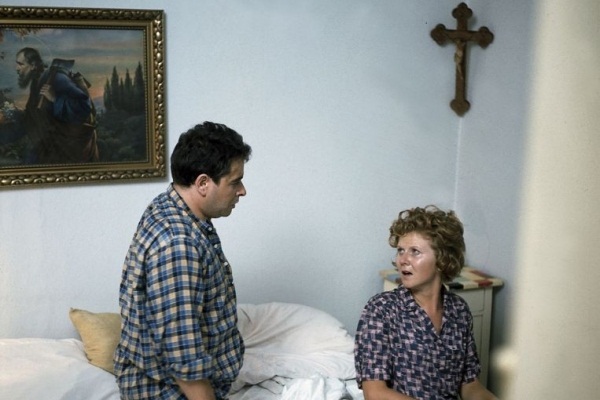
The Merchant of Four Seasons
The Merchant of Four Seasons was new, strange, and very German, but Farber and Patterson managed to naturalize it—not by invoking Brecht but by reading it through the prism of Andy Warhol. This was less a confluence of attitude than the recognition of a kindred mode of filmmaking—a common use of boldly simplified formats, a sexual frankness (the writers were particularly impressed by the "robust" scene with Irm Hermann, hitherto "all tightness," suddenly "exposed in all her white length, abandoned to pleasure") and sexual democracy ("like Warhol, all shapes and sizes are given their due as sexual creatures"), and most crucially an example of filmmaking as a process.
Farber and Patterson recognized Fassbinder was a pure product of the counterculture; they learned or intuited that his coterie somehow resembled the Warhol Factory and, as critics with an interest in and deep familiarity with the New York art world and the demimonde of underground film, they understood that for Fassbinder and his cohort, filmmaking was a way of life, a way to constitute a scene as well as control time and space.
By the time the Farber-Patterson piece appeared in Artforum, Merchant had been shown at the New York Film Festival, where it was hyped by Roud as Fassbinder’s "first great critical and popular success"—no doubt meaning in Paris—and "most accomplished film." The second-string New York Times reviewer Roger Greenspun did not cite Brecht or Warhol but found another way to naturalize this strange movie, opening with a description of an actress who had far less screen time than Irm Hermann—namely Hanna Schygulla. After this invocation of the muse, he went on to praise the movie in no uncertain, yet curiously oxymoronic terms, citing its "intellectual playfulness, its seriousness, its furtive ecstasy, its spare realism, its cruelty and its sometimes unnerving decency." The Merchant of Four Seasons was "neither easy nor ingratiating" but "very exciting [and] moving beyond all expectation."
Andrew Sarris, who also saw it at the NYFF, had a similar surprised response. He would later write that "Merchant of Four Seasons struck me with the full force of unwanted discovery"—an interesting concept. His review hailed it as "the most exquisite achievement in cinema to reach these shores from Germany since the Golden Age of Murnau, Lang, Pabst et al." Having thus situated the movie in a lost historical tradition, Sarris raised without really addressing the German question: "Unfortunately, New York audiences seem to have become studiously indifferent to German movies. It’s not anything one can put one’s finger on and label as bias, prejudice or backlash bigotry. It is simply a matter of massive non-interest." Whatever. Still, Sarris thought that, unlike Straub or Herzog, Fassbinder might cross over—thanks to a beautiful star. Like Greenspun (and many of us) Sarris was instantly smitten by Hanna Schygulla, offering her presence as additional motivation to see the movie. Too excited to be grammatically precise, he praised the actress’s "eyes and lips and womanly wiles to lead one to hell itself." Hell being…a German movie? [laughter]
The Merchant was also seen at the NYFF by exhibitor Dan Talbot, who recalled "trembling with excitement…not since Breathless had I seen a film that spoke to me with such originality." Here, the great Godard—only recently lost to his public through a conversion to Maoism—entered the equation and, at least for Talbot, reset the clock to 1960. A key independent exhibitor, Talbot had recently gone into distribution. He would at some point sign a contract to distribute 13 movies by Fassbinder, starting with The Merchant of Four Seasons. "I didn’t give a hoot if the cost of distributing these films would send my small company into bankruptcy." But there was also the possibility that he was investing in the new Godard. In that, he was prescient.4
The 1973 New York Film Festival featured Land of Silence and Darkness and The Bitter Tears of Petra von Kant. I saw Petra von Kant there—it was the only NYFF offering that year for which I bought a ticket. I’m not sure why (perhaps some advance word had reached me from Berkeley), but I recall enjoying it while at the same time being distracted by the action around the hall’s screen right exit. After half an hour it was like happy hour in a Western saloon. People were fleeing in droves. The New York Times reviewer Nora Sayre loathed it beyond all logic. On the one hand, she wrote, Fassbinder’s "women look like no one you’d ever meet, and he has filmed them under lighting that makes them look pastier and stranger than anyone encountered by flashlight in a sewer." On the other, the movie, however unfamiliar, was "a chronicle of blunders that film-makers have repeated throughout the decades." Merchant opened a month later downtown at the Greenwich and Sayre was dismissive: "Because of turgid directing and acting, most of the emotions in this picture ring false." Although less egregious than Petra Von Kant, the movie was nevertheless "soggy, dull, [and] appalling."
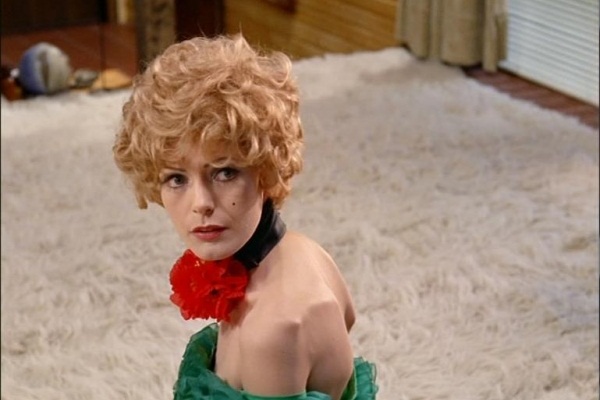
Margit Carstensen in The Bitter Tears of Petra von Kant
Sarris, however, published his rave review, and Merchant was revived in January 1974 at the First Avenue Screening Room, a small cinephile theater run by Talbot’s associate Fabiano Canosa, all but beneath the 59th Street Bridge—which is where I first saw it. The juggernaut was now launched.5
At the 1974 New York Film Festival, which also included Kluge’s Part Time Work of a Domestic Slave, Canby assigned himself to review the new Fassbinder, Ali: Fear Eats the Soul, a prizewinner at Cannes that was cautiously blurbed as "R.W. Fassbinder meets Fannie Hurst" rather than "Fassbinder remakes Sirk’s All That Heaven Allows." In any case, Canby chose to read it not as melodrama but anti-melodrama. He called the movie "courageous" and "free of the kind of realistic conventions that sentimentalize life’s mysteries." After the festival, Ali opened at the First Avenue Screening Room, where it might be appreciated by the cognoscenti.
The 1975 New York Film Festival had three West German films: Schlöndorff and von Trotta’s The Lost Honor of Katharina Blum, Straub and Huillet’s Moses and Aaron, and Fist-Right of Freedom, later Fox and His Friends, provocatively promoted as "homosexuality without tears." I’m not sure what Richard Roud meant but here we have another identity for Fassbinder. While homosexuality was commonplace in American underground movies, Fassbinder was the first openly gay or bi- or tri-sexual big-time filmmaker since Jean Cocteau, and Fassbinder was far less coy than Cocteau had ever been. As in most sexual matters, he was absolutely matter-of-fact.
This time Canby chose not to review Fox and His Friends and so the movie was dismissed in the New York Times by Richard Eder as "a Blue Angel done in drag," unredeemed by "its political message." Eder, who succeeded Nora Sayre, as a literate second-string reviewer put the movie in a larger context. His review began by noting that Fassbinder’s work "crosses the Atlantic each year to the New York Film Festival, where it tends to die…" In other words, we know this guy is supposed to be something in Paris but he is not. At this point, Fassbinder emerged as a cause among American cinephiles.
The November-December issue of Film Comment (possibly the first I ever purchased) was dedicated to "Emerging Cinema" as personified by Fassbinder, Ken Russell, and Marguerite Duras. In fact, it was a dossier on Fassbinder. Included were review-essays on Fox and Why Does Herr R. Run Amok? (still considered an important work), an interview with Fassbinder, and the long-awaited Farber and Patterson essay on Fassbinder, first published the summer before in Francis Ford Coppola’s City magazine. Farber and Patterson reiterated and elaborated on the Fassbinder-Warhol connection and again found a sort of American democracy at work in Fassbinder’s films, describing him as "A P.T. Barnum using workers and shopkeepers for his entertainers and making them as luminous and exotic as candelabras."6
The key text, however, was a piece of writing called "Fassbinder on Sirk" that was included in a small section devoted to Douglas Sirk. In addition to establishing a Fassbinder canon—Why Does Herr R. Run Amok?, The Merchant of Four Seasons, Ali: Fear Eats the Soul, Fox and His Friends—and allowing him to articulate his key concerns, the publication that was then the leading auteurist film journal in the U.S. emphasized Fassbinder’s link to Hollywood melodrama via Sirk. Fassbinder understood Sirk as an auteur. He was one of us!7
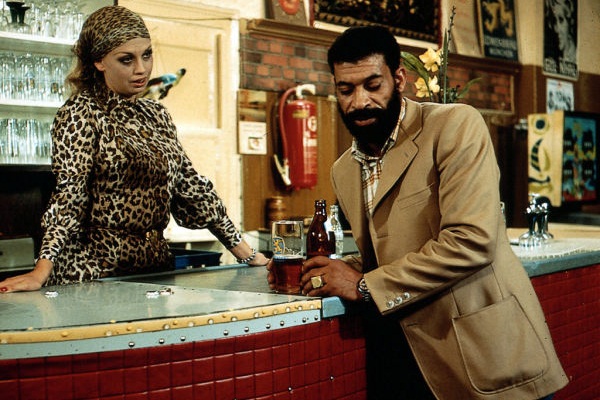
El Hedi ben Salem in Ali: Fear Eats the Soul
Thus naturalized in yet another fashion, Fassbinder was enlisted as a proxy in the war between auteurist and anti-auteurist critics. "Pity the national cinema whose summit achievements are the films of R.W. Fassbinder," sneered New York’s film critic John Simon, then strenuously promoting Lina Wertmüller as a new European film genius. Simon used the same piece to denounce Sirk as well. The anti-auteurist Pauline Kael, whose reign as America’s most influential film commentator roughly coincided with Fassbinder’s career, never once mentioned his name in the New Yorker although she evidently did see Merchant, which receives a capsule review in her book 5001 Nights at the Movies: "The film is considered by many to be a masterpiece, but the style of the director doesn’t have enough authority….[It’s] an art thing all right but perhaps not a work of art. And most important of all, it isn’t likeable."
In January 1976, New Yorker gave The American Soldier its theatrical premiere downtown at Film Forum. Canby reviewed, praising Fassbinder as "prodigiously talented." The next month, New Yorker opened Fox and His Friends at the Waverly (the same Greenwich Village theater where two months later The Rocky Horror Picture Show would begin its epochal midnight run). A modest hit, Fox ran for at least three weeks with the word "homosexual" prominently used in its ads—thus giving the filmmaker another public identity.
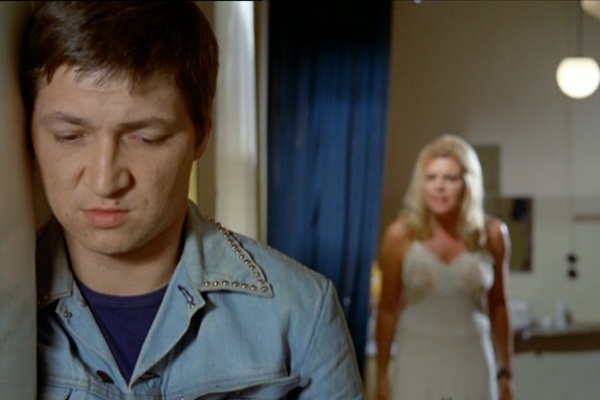
Rainer Werner Fassbinder in Fox and His Friends
The 1976 New York Film Festival introduced Wim Wenders with Kings of the Road, included its last Kluge film, Strongman Ferdinand, and Fassbinder’s Fear of Fear. Canby’s review called Fassbinder "the most fascinating, talented, prolific, original young film maker in West Germany and, for that matter, one of the most exciting in Western Europe today." When, a month after the NYFF, New Yorker opened Beware of a Holy Whore at Film Forum, Canby found it "as fascinating and dissonant as might be wished by anyone who admires this young German filmmaker as I do." It is worth noting the extraordinary nature of Canby’s support for this "very young, very gifted filmmaker," as well as the mention made in his review of Warhol and Godard.
And now, in late 1976, we approach critical mass…
Writing in the Village Voice, Andrew Sarris wonders, "Can Fassbinder Break the Box Office Barrier?" Why not? Rocky was the sleeper of the year and Jimmy Carter had just been elected president. In February 1977, the New York Times publishes a piece datelined Munich and headlined "A New Director Movie Buffs Dote On" that asks if Rainer Werner Fassbinder is "the messiah of the new German film." Then, less than a month later, Canby publishes a piece, "Rainer Fassbinder—The Most Original Talent Since Godard," that declares Fassbinder’s oeuvre to be "the most exciting and original body of work by any modern director anywhere in a comparable period of time."
The occasion for Canby’s piece is an unprecedented, three-month retrospective at Talbot’s New Yorker theater that will include seven premieres: Mother Küsters Goes to Heaven, Chinese Roulette, Jail Bait, Katzelmacher, Gods of the Plague, Effi Briest, Satan’s Brew. All were reviewed by Canby, who even found kind words for Chinese Roulette and outdid himself in praising what was experienced as Fassbinder’s first conventional European art film, Effi Briest. Fassbinder was now the equivalent of a rock star—at least in the cineaste world.8
Researching this talk, I found something quite poignant in the New York Times. On July 30, the newspaper ran a story headlined "U.S. ‘Freedom’ to German Director." Fassbinder told an American reporter that he was through with Germany and hoped to relocate to New York City: "The first thing I plan to do is look for a house in the Village to settle down there….That is what I want, just to live there." Had it happened it would have been remarkable. Fassbinder’s American friends, who regarded him as the most significant filmmaker working anywhere in the world, would have been twice validated.9
For the first time in seven years, the New York Film Festival had no Fassbinder movie—it needed none. (West Germany was represented by Wenders’s The American Friend and Herzog’s Heart of Glass.) The 1978 NYFF offered something of a shock: the international co-production Despair. This was not only Fassbinder’s most blatantly commercial movie but—and to my mind—a disastrous sellout.
The 1979 NYFF, which included In a Year of 13 Moons and closed with The Marriage of Maria Braun, suggested that there might now be two aspects to Fassbinder’s production. Canby praised 13 Moons with the caveat that "it was not a film to recommend to anyone who isn’t familiar with this most bitterly funny, talented and prolific West German director….Without adequate preparation, the uninitiated movie patron might think he was having a nightmare about a nightmare." On the other hand Maria Braun "may be Mr. Fassbinder’s most perfectly realized comedy to date." Certainly, it was Fassbinder’s great commercial success although the image of its star in a corset and stockings striking a legs akimbo Marlene Dietrich pose probably sold more tickets than Canby’s review. As Sarris would write in his obituary: "It’s hard to think of Fassbinder apart from the glowing image of Hanna Schygulla."
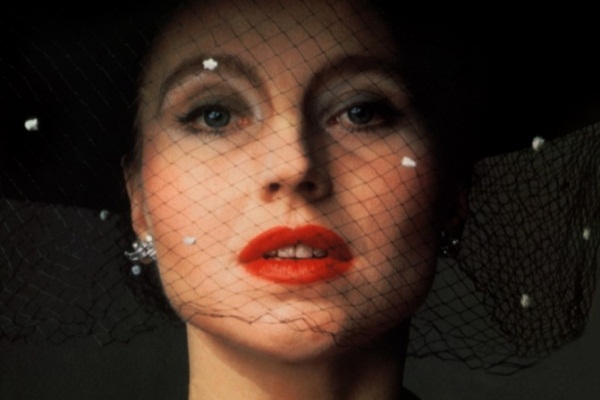
Hanna Schygulla in The Marriage of Maria Braun
Maria Braun opened out of the NYFF across the street at Talbot’s new theater Cinema Studio and ran there for 53 weeks. It was still playing there when Talbot elected to bypass the next NYFF and open Fassbinder’s last "non-commercial" release, The Third Generation, at the downtown Public Theater. The venue mattered not to Canby: "There can no longer be any doubt about it: Rainer Werner Fassbinder is the most dazzling, talented, provocative, original, puzzling, prolific and exhilarating filmmaker of his generation….The Third Generation is fascinating. It’s also worrying. I keep wondering how long Mr. Fassbinder can continue this remarkable pace." Not much longer.
Lili Marleen, released by United Artists, opened at an East Side theater in July 1981 ahead of another Fassbinder retro, this one at Film Forum. Even more commercial than Maria Braun, it was the director’s first film to which—after an unprecedented near decade of raves—Canby gave a mixed review.
Dead, Fassbinder’s prestige reached stratospheric heights. Lola (1981) and Veronika Voss (1982) were released posthumously, the latter providing the NYFF’s opening night. When Berlin Alexanderplatz had its theatrical premiere at Cinema Studio during the summer of 1983, it was hailed as a culminating masterpiece. Canby wondered if it were the future of movies. "The panoramic scope…its sheer exhilarating length…prompts a reconsideration of the shape of narrative films and of the serious possibilities of what television calls mini-series. It also challenges the resources of commercial film distribution as well as the manner in which we look at films. Fourteen months after his death, at the age of 36, this most brilliant and least conventional film director of his generation continues to come up with experimental methods that could, conceivably, become the conventions of tomorrow."
In a way it was. Berlin Alexanderplatz was an astonishing success. ("There were never better reviews for a German film in America," I was told by Ingrid Scheib Rothbart, for many years the head of the local Goethe Institute’s film program.) And in a way, it wasn’t. Some 14 years later, on the occasion of a full Fassbinder retro at the Museum of Modern Art, a booker at New Yorker Films bluntly explained that Fassbinder was "totally dead in theatrical." I should note that 1997 was also the year of Susan Sontag’s famous article on the death of cinephilia, which is to say that Fassbinder’s second death was part of a larger phenomenon.
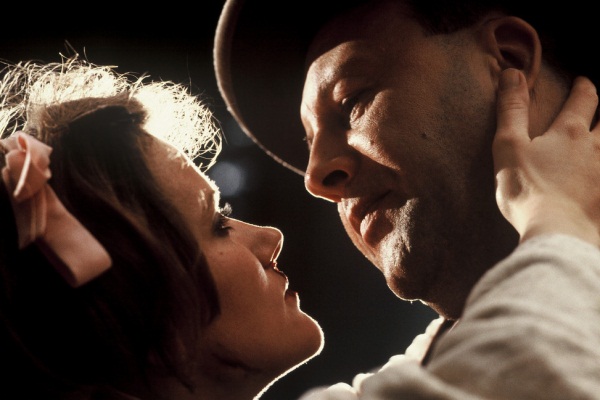
Berlin Alexanderplatz
Fassbinder’s current U.S. reputation is paradoxical. There is no question that he had an effect on U.S. filmmakers, not least because he was, at least at first, a paragon of economic production. The punk Super-8 filmmakers of the late ’70s and early ’80s were deeply impressed by this, as well as his talent for offending the John Simons of the world. Gregg Araki and the filmmakers identified with the New Queer Cinema of the late ’80s and early ’90s were clearly inspired by Fassbinder. Established independents like John Waters and Mark Rappaport show his influence as well, as do members of the following generation: Jim Jarmusch, Todd Solondz, Todd Haynes, Richard Linklater.
Fassbinder was a major intervention in U.S. film culture—the single greatest influence on American indies. And he remains relevant! Witness the excitement—at least among film intellectuals—that greeted his 1973 World on a Wire when it had its U.S. premiere two years ago. "It is perhaps inevitable that we are still catching up with Rainer Werner Fassbinder, who worked practically at the speed of thought," Dennis Lim wrote in the New York Times. Here was a movie that presaged The Matrix, Avatar and even the Mad Men look currently in vogue—but the times had changed. It would have scarcely more currency, and perhaps less, than the first few Fassbinder productions that trickled out in the early ’70s.
Let me end by quoting from an essay published in Cineaste in 2004 on the occasion of the DVD release or re-release of some 20 Fassbinder titles. Tony Pipolo might almost be describing the anticipation around the release of John Wesley Harding or The White Album when he begins by noting that, "from the mid-1970s through the early 1980s, the arrival of a new Fassbinder movie was an event….While there were other important West German filmmakers, it was Rainer Werner Fassbinder who put the New German Cinema on the map and with his death in 1982, virtually erased it. In the twenty years since, nothing comparable to Fassbinder’s brief but galvanizing engagement with cinema has emerged in Germany." Or, I would add, anywhere else. The sense of nostalgia is palpable.
Godard and Warhol remain sources of fascination even for younger generations—Fassbinder, not so much. The reason is that, frequently revived and endlessly cited, Godard and Warhol embody the ’60s, including what was experienced as ’60s radical cinephilia. Fassbinder, at least in American film culture, was embraced as their natural successor. Throughout the 1970s, he was felt to be almost single-handedly keeping alive a certain passion for cinema and a dynamic sense of cinematic history. He was, as Farber and Patterson put it, "the single antidote to thoughts of suicide." You could say that Fassbinder was the original ’60s revival. In other words, he was already living the afterlife and there may be nothing after that.
1. Time and lack of firsthand knowledge precludes discussion of the significant role played by British film intellectuals and the Pacific Film Archives in Berkeley in establishing Fassbinder’s American reputation.
2. Susan Sontag, "Fox and His Muse: Fassbinder Star Hanna Schygulla Revealed," Village Voice (2/26/2003). This sometimes contentious exchange has other gems.
3. In April 1972, a second Fassbinder film—Why Does Herr R. Run Amok?—was shown as part of a show of the "New German Cinema" at the Museum of Modern Art where, like Werner Schroeter’s Salome, it was regarded as an oddity. It was also shown at Pacific Film Archives, introduced by Manny Farber, where a friend of mine saw it. His enthusiastic reaction was the earliest report I remember receiving on Fassbinder.
4. With his own theaters, Talbot had a unique advantage. He did not have to persuade an exhibitor that there was an audience for Fassbinder—he was in a position to develop one himself.
5. Shortly before the 1974 NYFF, the New York Cultural Center—a small eccentric museum in the middle of Columbus Circle with an adventurous film program—hosted New York City’s first Fassbinder retro. (The seven films shown included Beware of a Holy Whore, Katzelmacher, Herr R., Petra von Kant, and Effie Briest.) To my knowledge, the show, undoubtedly organized with the help of the Goethe Institute, went unmentioned in both the New York Times and Village Voice.
6. The issue also included Farber and Patterson’s report on the 1975 NYFF, which praised Fox with consummate ambiguity ("the festival’s most deceptive movie is loaded with standard clichés").
7. In the discussion that followed, Thomas Elsaesser pointed out that British critics had already rehabilitated Sirk in the English-speaking world (e.g., the Summer 1971 issue of Scree, devoted to Sirk) and discussed his significance for Fassbinder. A monograph on Sirk, published on the occasion of the 1972 Edinburgh Film Festival, included Fassbinder’s "Six Films by Douglas Sirk" (first published in Fernschen und Film in February 1971). Elsaesser noted that it was he who had discovered this piece—tartly adding that Film Comment gave him no credit for his translation, which in fact they did.
8. Then a graduate student in Columbia’s film program, I can attest that nothing—save maybe the preview of Star Wars—caused more interest among my colleagues than the Fassbinder retro.
9. In the discussion that followed the presentations, it was suggested that Fassbinder’s main reason for relocating to New York was his interest in the local gay bars. Maybe so but that only reinforces the sense that, for him, the city seemed to offer the possibility of love—or at least appreciation—unavailable in West Germany. That this announced move was considered newsworthy is suggestive of the New York Times’s own investment in Fassbinder. ![]()
LATEST ARTICLES
-20140814-173707-thumb3.jpg)
Fighting Words
by Imogen Sara Smith
posted August 12, 2014

Fighting Words, Part 2
by Imogen Sara Smith
posted August 20, 2014

On the Margins: The Fil…
by Andrew Chan
posted August 12, 2014

Robin Williams: A Sense…
by David Schwartz
posted August 12, 2014
 The Single Antidote to Thoughts of Suicide
The Single Antidote to Thoughts of Suicide
KEYWORDS
Rainer Werner Fassbinder | German Cinema | Retrospective | auteurism | New York | film criticism | Andy Warhol | Dan Talbot | cinephilia | Vincent Canby | sexuality | Jean-Luc Godard | Andrew SarrisTHE AUTHOR
J. Hoberman is a renowned film critic whose latest book, Film After Film: What Became of 21st Century Cinema, was published by Verso. He was the senior film critic at the Village Voice, and he now writes for numerous publications including Artinfo.net and The Tablet. His writing is aggregated at his website, j-hoberman.com.
More articles by J. Hoberman
